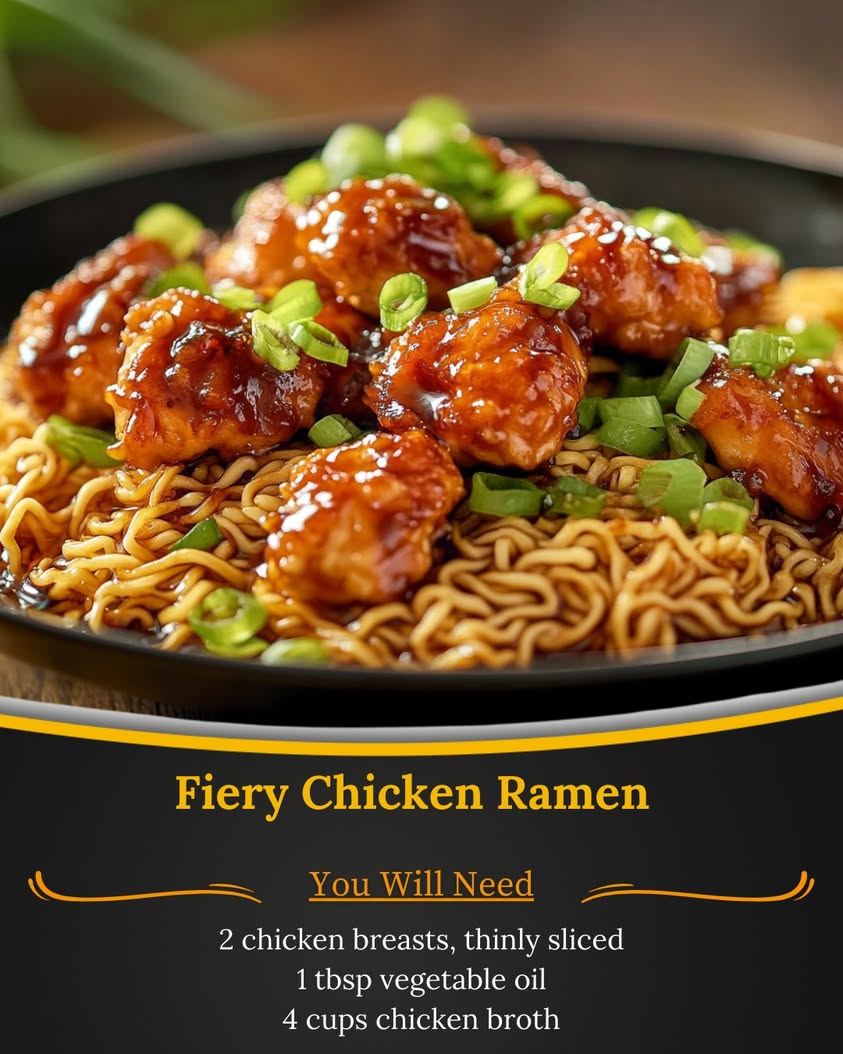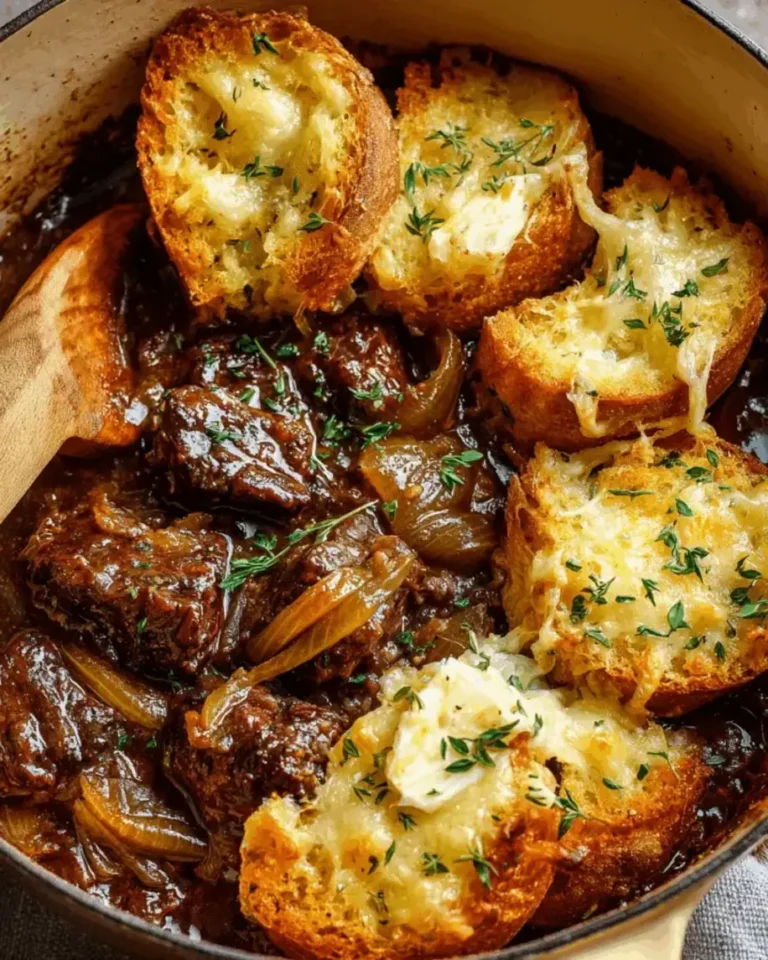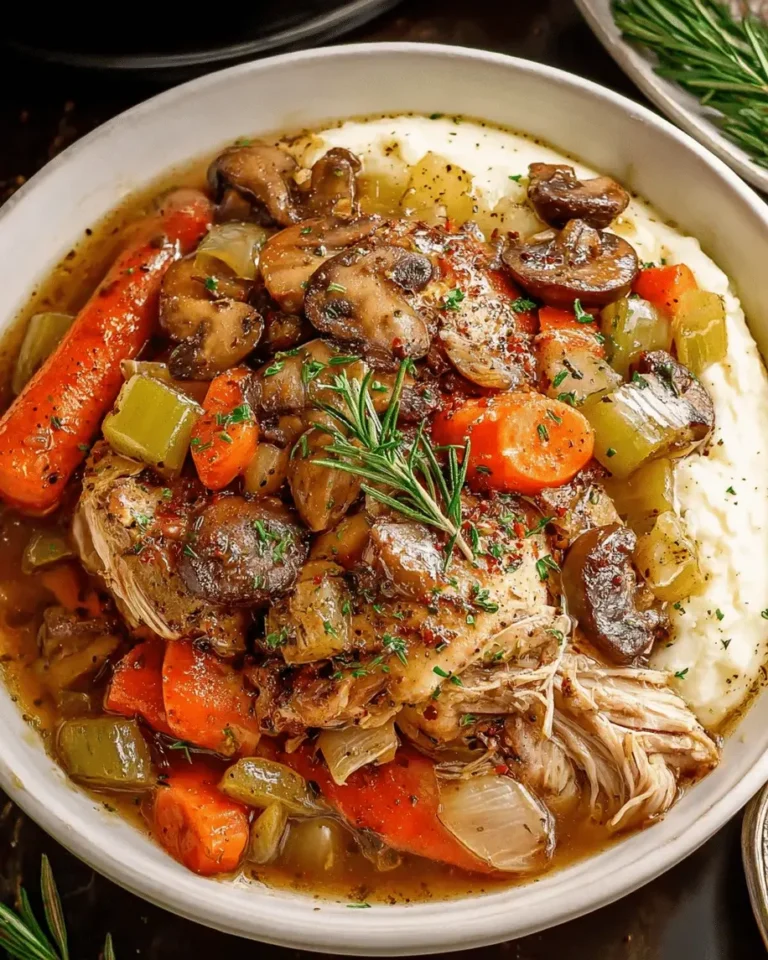Spice Up Dinner with Fiery Chicken Ramen Recipe

Fiery Chicken Ramen: A Spicy Twist to a Classic Dish
If you’re craving a delightful fusion of spicy flavors and comforting warmth, look no further than this Fiery Chicken Ramen recipe. This dish combines tender chicken with the rich umami of miso broth, topped with fresh vegetables and a hint of chili heat, creating a satisfying bowl that will excite your taste buds. Each slurp reveals layers of flavor, reminiscent of the bustling streets of Japan, and it’s sure to become a family favorite.
This Fiery Chicken Ramen is more than just food; it’s an experience. The broth is deeply infused with spices, providing a warm and inviting aroma that fills your kitchen. As you prepare this dish, you can expect a vibrant and colorful presentation, with fresh greens, succulent chicken, and perfectly cooked noodles swimming in a savory broth. This visually appealing dish is equally nourishing and comforting, making it perfect for cool evenings or when you’re feeling under the weather.
Quick Recipe Highlights
- Flavor Profile: The combination of spicy red chili paste, savory miso, and fresh ingredients creates a robust flavor experience that is both spicy and savory.
- Texture: The ramen noodles provide chewiness, while tender chicken and crisp vegetables offer a delightful contrast to the smooth broth.
- Aroma: With notes of garlic, ginger, and chili, this dish has an enticing aroma that fills the air, drawing everyone to the table.
- Visual Appeal: This dish radiates vibrancy with its colorful array of garnishes, making it a feast for the eyes as much as for the palate.
- Skill Level Needed: A basic understanding of cooking techniques is sufficient, making this an approachable recipe for both novice and experienced cooks.
- Special Equipment: You’ll need a large pot for the broth, a smaller pot for the noodles, and a good knife for chopping ingredients.
Recipe Overview
- Difficulty Level: This recipe is rated as intermediate, as it involves sautéing, simmering, and ensuring the noodles don’t overcook.
- Category: Perfect for a hearty dinner, this ramen can also be served as a filling lunch or impressive meal for guests.
- Cuisine: Inspired by Japanese culinary traditions, this dish incorporates elements of ramen and miso soup while adding a personal spicy twist.
- Cost: This recipe is cost-effective, with estimates at about $15 for four servings, making it affordable for feeding a family.
- Season: Ideal for cooler months, this warming dish is particularly delightful during fall and winter when comfort food is most appreciated.
- Occasion: Serve this dish during casual family dinners or as a special treat for friends gathering at your home.
Why You’ll Love This Recipe
This Fiery Chicken Ramen delivers a balance of taste and texture, with the spicy miso broth tantalizing your palate, and the fresh toppings adding a crunch to every bite. Tender chicken offers protein while the noodles provide the comfort that we all crave in a warming dish. It’s a celebration of flavors that satisfies both hunger and craving for something hearty yet spicy.
This recipe stands out for its convenience; you can easily prepare it in less than an hour. Most ingredients are readily available at your local grocery store, allowing for quick preparation even on busy weeknights. The use of simple techniques makes it an accessible choice for anyone looking to impress without hours spent in the kitchen.
Nutritionally, this ramen is a powerhouse. Loaded with protein from chicken and vital nutrients from fresh vegetables, it’s a comforting meal you can feel good about. It’s balanced, satisfying, and will leave you feeling nourished rather than weighed down.
Beyond the flavorful experience, this dish excels in social situations. Share big bowls of steaming ramen with friends and family, igniting lively discussions over the comfort of good food and spiciness. Its communal nature makes it a perfect centerpiece for gatherings, allowing everyone to personalize their dishes with their choice of toppings.
Cost-effective and easy to make, this recipe is designed to fit into your budget. With a modest investment, you can create a meal that rivals any restaurant’s offerings, making it an ideal go-to for weeknight dinners and casual entertainment alike.
Historical Background and Cultural Significance
Ramen has a rich history in Japanese cuisine, originating from Chinese noodle soup dishes brought to Japan in the late 19th century. Over the decades, it evolved into the beloved ramen we know today, with each region developing unique variations. The Fiery Chicken Ramen stands as a testament to this evolution, introducing a spicy twist to the traditional flavors.
Throughout Japan, ramen has become more than just food; it carries cultural significance. It is a symbol of comfort and a meal that brings people together. Street vendors and specialty shops are found in every city, each with their own secret recipes. The cultural importance of sharing a bowl of ramen reinforces connections between friends and family, celebrating the Japanese value of community.
This recipe reflects the evolution of ramen, showcasing how traditional flavors can be adapted to modern palates. As culinary boundaries continue to blur, dishes like Fiery Chicken Ramen demonstrate the creativity home cooks bring into their kitchens while maintaining respect for time-honored traditions.
Regional variations of ramen abound, from the rich tonkotsu in Fukuoka to the lighter shoyu in Tokyo. This Fiery Chicken Ramen adds a special twist, illustrating flexibility within the framework of ramen while adapting to local tastes and spice preferences.
Ingredient Deep Dive
Chicken
Chicken is a staple protein in many cuisines worldwide, valued for its versatility and rich nutritional profile. In ramen, it serves as both a primary ingredient and a flavor base for the broth. Opting for chicken thighs instead of breasts can enhance the richness due to their higher fat content, bringing additional depth to the ramen.
Nutritionally, chicken packs a punch with high protein levels, essential for muscle repair and immune function. When choosing chicken, look for organic options when possible, as they often have better flavor and are raised without antibiotics. Store chicken in the refrigerator if it will be used within a couple of days or freeze it for longer preservation.
Miso Paste
Miso paste is a fermented soybean product that adds umami flavor to various dishes, including ramen. Integral to Japanese culinary culture, miso brings not only taste but also health benefits, such as probiotics, which promote gut health. There are several varieties of miso, from white (sweet) to red (savory), each with unique flavor profiles that can alter your ramen’s character.
When selecting miso, find options that are labeled as unpasteurized for maximum probiotic benefits. Store miso in the refrigerator to extend its shelf life; it can last for months if stored properly. If you don’t have miso on hand, tahini, or even soy sauce, can serve as substitutes, though they won’t fully replicate miso’s distinct taste.
Ramen Noodles
Ramen noodles are essential in this dish, providing the primary carbohydrate source. These wheat noodles have a unique texture achieved through the addition of kansui, a type of alkaline mineral water that gives ramen its characteristically chewy texture. Their origins trace back to Chinese noodles, yet they hold a unique place in Japanese cuisine, with chefs often making fresh noodles.
For optimal freshness, choose fresh or homemade ramen noodles when possible. If not, dried noodles work well; just ensure to follow the cooking instructions carefully. Store dried ramen noodles in a cool, dry place, while fresh ones should remain refrigerated and consumed promptly.
Vegetables
Adding fresh vegetables such as bok choy, green onions, and mushrooms elevates the dish. These vegetables not only bring vibrant colors but also crucial vitamins and minerals. For instance, bok choy is rich in calcium and vitamins A and C, making it a great addition to your ramen for both health and crunch.
Selecting seasonal vegetables guarantees better flavor and nutritional value. Store fresh vegetables in a cool, dry place, and use them within a week to lock in their freshness. Feel free to swap in other vegetables like spinach or carrots based on your preferences or availability.
Chili Paste
Chili paste, a critical component in making this ramen fiery, provides that essential kick. Originating from various cuisines, it varies in heat and flavor, ranging from sweet to extremely spicy. This ingredient exemplifies the global fusion within this recipe, bringing an exciting element to the table.
When selecting chili paste, consider the level of heat you enjoy. Store it in a cool and dark spot, and it can last for several months. For milder variations, substitute with sriracha or even a hint of cayenne pepper to achieve the necessary flavor profile with controlled heat.
Common Mistakes to Avoid
- Overcooking the noodles: Ramen noodles require boiling for only a few minutes. Overcooking them can lead to mushy, unappetizing noodles that lose their desirable chewiness.
- Neglecting the broth: The flavor of the broth is crucial in ramen; skimping on herbs, spices, or simmering time can lead to bland results. Take time to develop the flavors by simmering adequately.
- Using cold ingredients: Ensure that vegetables and other toppings are fresh and ready to serve. Putting cold toppings on hot ramen can diminish the overall experience.
- Incorrect knife skills: Slice vegetables uniformly for even cooking. Uneven cuts may result in some vegetables being undercooked while others turn mushy.
- Forgetting about garnishes: Toppings add both flavor and visual appeal. Don’t skip on garnishes like green onions, boiled eggs, or sesame seeds that provide the dish its final personality boost.
- Skipping the taste test: Always taste your broth while cooking. Adjust seasoning actively rather than waiting until the dish is complete, ensuring a well-seasoned final product.
- Not letting the broth simmer: Quick-cooking broth can lack depth. Allowing it to simmer builds rich, layered flavors that define excellent ramen.
- Ignoring personal spice levels: Adjust the amount of chili paste based on your group’s preference. A fiery dish may not appeal to everyone; keep options available.
- Cutting corners on ingredients: Quality matters! Using fresh ingredients with minimal preservatives will yield the best flavors and noodles.
- Using only one type of ingredient: Ramen is about harmony; combine different proteins, vegetables, and spices to create a balanced and enjoyable dish.
Essential Techniques
Simmering the Broth
Simmering your broth correctly is crucial for extracting flavors from your ingredients. Start by heating oil, then adding aromatics like garlic and ginger to bloom their flavors. Allow your broth to simmer on low for an extended time to develop flavor depth while skimming impurities for a clearer broth.
To master this technique, keep the pot at a low simmer instead of a rolling boil; high temperatures can lead to a cloudy broth. Taste regularly to adjust and perfect the seasoning. Look for a rich color and fragrance as cues of success.
Cooking the Noodles
Perfectly cooked ramen noodles are essential for an enjoyable experience. Follow package instructions for timing, typically boiling them for just a few minutes. When done, rinse them in cold water to halt the cooking and preserve their texture.
To master this technique, keep a close eye while cooking and taste for doneness. Draining too early or too late can affect the overall dish. Aim for a firm, chewy bite as the ultimate success indicator.
Preparing Protein
Achieving tender chicken is paramount in this dish. For poached chicken, start by bringing the water to a gentle simmer, then adding seasoned chicken for even cooking. Ensure it’s not boiling vigorously to maintain tenderness.
Use a meat thermometer to check for doneness; chicken should register at 165°F. Avoid overcooking, which leads to dryness, and take care to slice it against the grain for optimal texture and flavor.
Chopping Vegetables
Uniform vegetable cuts not only enhance presentation but also ensure even cooking. Invest time in mastering knife skills, as this promotes a pleasing balance of textures in each bowl.
To achieve consistency, practice julienning and dicing; utilize a sharp knife for precision. Visual cues like a slight sheen from oils or cooked uniformity signal the right techniques applied here.
Pro Tips for Perfect Fiery Chicken Ramen
Even small adjustments can elevate your Fiery Chicken Ramen. Start with freshly made stock for maximum flavor; homemade broth is always superior to store-bought alternatives.
Consider marinating your chicken in soy sauce and sesame oil before cooking; this adds depth and flavor. Additionally, don’t shy away from experimenting with toppings. Try adding toasted seaweed or a sprinkle of furikake for added umami satisfaction.
Temperature control is key; serve ramen piping hot, and warm the bowls beforehand to keep your dish at the optimal temperature. Lastly, include a soft-boiled egg with a runny yolk for that perfect, creamy finish.
Variations and Adaptations
The great thing about ramen is its versatility; feel free to swap ingredients to customize the dish. For a seafood twist, substitute chicken with shrimp or fish, utilizing miso broth to maintain depth.
Consider seasonal adaptations by incorporating vegetables based on availability; spring peas or corn can create a fresh seasonal taste. For dietary modifications, feel free to use gluten-free noodles or omitting animal products to create a vegan version.
Flavor variations can be achieved by experimenting with different chili pastes or miso types. To change the texture, use zoodles (zucchini noodles) for a low-carb twist. For a fun presentation, serve ramen in individual bowls with a colorful array of toppings, inviting guests to build their bowls.
Serving and Presentation Guide
Plating plays a vital role in enhancing your ramen’s appeal. Start by ladling the broth into warmed bowls, then artfully arrange the noodles and toppings. Consider layering for height; this adds visual appeal and engages your guests.
Garnish with fresh herbs like cilantro, slices of lime, or sesame seeds for a pop of color. Traditional accompaniments like pickled ginger or nori add authenticity, while modern touches such as chili oil swirls can elevate the experience further.
Serve steaming hot to retain the best flavor and warmth. Ensure portion sizes are adequate but not overwhelming, allowing guests to enjoy a couple of bowls if desired without feeling overly stuffed.
Wine and Beverage Pairing
Selecting the right beverage can elevate your ramen experience. Pairing a light, crisp sake complements the heat of the broth seamlessly. Alternatively, consider a dry Riesling or even a light lager to cut through the spiciness while refreshing the palate.
For those preferring non-alcoholic options, green tea or chilled jasmine tea offers satisfying harmony. These beverages also provide cleansing flavors, enhancing your enjoyment of the meal. Serve all drinks chilled to counterbalance the warmth of the ramen.
Storage and Shelf Life
Proper storage affects both flavor and health properties of your ramen. Store leftovers in airtight containers, keeping the broth separate from noodles to preserve their texture. Refrigerate for up to three days for optimal freshness.
If you plan to store the ramen for a longer time, consider freezing the broth, which can last for several months. For reheating, warm broth on low to prevent burning, while cooking noodles fresh to maintain desirable texture. Always check for signs of spoilage, such as off smells or discoloration before serving.
Make Ahead Strategies
Preparation can streamline your cooking process. Consider making the miso chicken broth ahead of time, allowing flavors to meld overnight. Store in portions for quick use during busy weeknights.
You can prep vegetables by washing, dicing, and storing in advance, reducing cutting time when cooking the ramen. For the best flavor, avoid pre-cooking the noodles, as they are best when freshly boiled for texture.
When reheating, focus on adding fresh, vibrant elements like herbs and textures that may lack in the reheated versions. Assemble just before serving for a delightful presentation.
Scaling Instructions
Scaling this Fiery Chicken Ramen recipe is a breeze. To halve the recipe, cut all ingredients in half and adjust the water accordingly for the broth. For doubling or tripling portions, ensure you have a large enough cooking vessel to accommodate the bulk.
Take care with timing as larger batches can require slightly longer cooking times for flavors to meld adequately. Always taste as you go to ensure flavor profiles remain balanced, and be prepared to adjust seasonings accordingly.
Store extra servings in individual portions for easy meals throughout the week, ensuring the freshest experience for each bowl.
Nutritional Deep Dive
This Fiery Chicken Ramen boasts a robust nutritional profile, rich in protein from chicken and packed with vitamins from an array of vegetables. A typical serving maintains a balance of macronutrients, offering energy without excessive fat.
The use of miso adds vital probiotics, contributing to gut health, while spicy elements can bolster metabolism. Including various vegetables elevates fiber content, promoting digestion and overall health.
Portion control can be managed by balancing broth and noodles against proteins and vegetables. This will help reach satiety without excess calories, making it an excellent choice for those monitoring their intake.
Dietary Adaptations
For gluten-free diets, substitute traditional ramen noodles with rice noodles or spiralized vegetables like zucchini. Ensure miso doesn’t contain any wheat ingredients by checking labels for gluten-free options.
For dairy-free meals, none of the primary ingredients contain dairy, making this recipe inherently suitable. Vegans can replace chicken with tofu or seitan, providing a protein source while retaining the flavor profile with vegetable-based broth.
Those on low-carb diets can use konjac noodles or cauliflower rice as a noodle alternative. Adjusting the spice can also appeal to those following the low-FODMAP diet, ensuring delicious experiences for everyone.
Troubleshooting Guide
If you encounter texture issues, such as overcooked noodles, adjust timing and make sure to drain and rinse them after boiling. Under-seasoned broth can easily be corrected by adding soy sauce or miso incrementally.
For flavor balance, if the broth is too salty, dilute it with water or low-sodium broth and adjust with additional vegetables. If spice levels are off, add sugar to counteract heat or mild chili paste to enhance flavors without overwhelming.
If you experience temperature problems, ensure that cooking vessels are preheated, and keep all elements warm until plating. For equipment challenges, ensure your knives are sharp for clean cuts and your pots can handle the volume required.
Recipe Success Stories
Readers have shared their love for this Fiery Chicken Ramen, noting its bold flavors and comforting attributes. Some have embraced the experimental nature by adding their own twists, such as incorporating seasonal vegetables or swapping the protein based on personal preferences.
Many also appreciate how it brings families together for meal prep, allowing everyone to add their toppings. Users highlight the satisfaction they find in trying their hand at homemade ramen for the first time, often posting beautiful pictures showcasing their creations.
Newcomers to cooking have praised the beginner-friendly instructions, making this recipe a go-to for intimate gatherings or casual dinners. The communal experience of serving it adds value to the simple joy of sharing food.
Frequently Asked Questions
Can I make this ramen vegetarian?
Yes! Simply replace chicken with tofu or tempeh and ensure you are using vegetable broth instead of chicken broth for a fully vegetarian treat.
How can I store leftovers?
Store the broth separately from the noodles in airtight containers. They can be refrigerated for up to three days, or you may freeze the broth for longer shelf life.
Can I make this dish gluten-free?
Absolutely! Use gluten-free ramen noodles or spiralized vegetables like zucchini in place of traditional ramen for a satisfying alternative.
Is there a way to decrease the heat level?
Yes! Simply adjust the amount of chili paste to your taste, or use a mild version. You can always provide additional chili paste on the side for those who enjoy more heat.
How can I enhance the broth flavor?
For a deeper flavor, consider simmering the broth longer or adding a dash of soy sauce, and a few cloves of garlic during the cooking process for additional depth.
What’s the best way to serve this to guests?
Set up a ramen bar with all the toppings on one table, allowing your guests to customize their bowls. This engages everyone and makes the dining experience interactive.
What if my broth becomes too salty?
To balance excess saltiness, you can dilute your broth with additional water or low-sodium broth. Alternatively, incorporating more vegetables can help absorb some saltiness.
Can I use another type of protein?
Yes! Experiment with pork, shrimp, or even fish based on your preference. Each protein adds a unique touch to your ramen.
How long does it take to prepare?
This dish takes about 45 minutes total, including prep and cook time, making it a fabulous option for a weeknight dinner.
Can I freeze the ramen?
While it’s best to freeze broth, noodles tend to lose texture when frozen. For maximum freshness, freeze just the broth and prepare fresh noodles when ready to serve.
Additional Resources
If you’re intrigued by ramen, explore related recipes like Tonkotsu Ramen or Miso Soup to further expand your Japanese culinary repertoire. Check out technique guides on making homemade broth or mastering vegetable preparation to elevate your cooking experience.
Ingredient information is key; explore nuances in miso paste to understand varieties and flavor profiles. Equipment recommendations can help refine your ramen-making process, so consider investing in a high-quality pot or traditional ramen bowls for that authentic feel.
Join the Conversation
We invite you to share your experience with our Fiery Chicken Ramen. Share photos of your delicious bowls on social media and join our growing community of ramen enthusiasts. Engage by sharing variations you try or how you customize the recipe for your taste. Recipe reviews and feedback help us improve and create even more delicious options for you!
The Recipe
Fiery Chicken Ramen
Serves: 4 Servings
Prep Time: 15 mins
Cook Time: 30 mins
Total Time: 45 mins
Kitchen Equipment Needed
- Large pot
- Smaller pot for noodles
- Sharp knife
- Cutting board
- Saucepan
- Measuring cups & spoons
Ingredients
- 2 boneless, skinless chicken thighs, sliced
- 1 tablespoon chili paste (adjust to taste)
- 1 tablespoon miso paste
- 4 cups chicken broth
- 2 cups fresh ramen noodles
- 1 cup bok choy, chopped
- 1 bunch green onions, sliced
- 1 cup mushrooms, sliced
- 2 cloves garlic, minced
- 1 inch ginger, minced
- Sesame seeds for garnish
- Soft-boiled eggs (optional) for topping
Directions
- In a large pot, heat oil over medium heat, then add minced garlic and ginger, stirring until fragrant.
- Add sliced chicken thighs and cook until browned.
- Stir in chili paste and miso, mixing well.
- Pour in chicken broth, bring to a boil, then reduce to a simmer for 20 minutes.
- In another pot, cook ramen noodles according to package instructions; drain and rinse.
- Add bok choy and mushrooms to broth, cooking for an additional 3-5 minutes.
- Serve noodles in bowls, ladle hot broth and chicken mixture over the top.
- Garnish with green onions, sesame seeds, and soft-boiled eggs if desired.
Recipe Notes
- Feel free to adjust the spiciness based on your preferences.
- Experiment with toppings for added flavor and texture variations.
- This recipe can easily be scaled for larger groups.
- Consider using leftover rotisserie chicken for a quicker preparation time.






